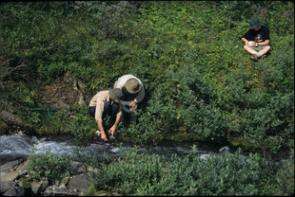Microscopic Geochemical Processes Point to Potential Problems If the Arctic Warms

A little-known valley in northern Sweden holds evidence that warming temperatures may lead to significant changes in nutrient availability for plants and increasing amounts of greenhouse gases, a University of Arkansas researcher and his colleagues say.
“Warming temperatures could have tremendous implications for global nutrient cycling and the so-called greenhouse gases,” said John C. Dixon, a geosciences professor in the J. William Fulbright College of Arts and Sciences. Dixon, Robert Darmody, a soil scientist, and Colin Thorn, a geomorphologist, both at the University of Illinois, have recently completed 15 years of work at Kärkevagge, Swedish for “Valley of the Boulders.”
They studied rock, soil and water samples and conducted experiments in this pristine valley in northern Sweden, based at Abisko, the northernmost year-round operating science research station in the world, run by the Swedish Academy of Sciences.
Kärkevagge holds two advantages for researchers: First, it is a pristine environment, one untouched by human development. Second, the valley’s high altitude allows the researchers to study geochemical processes in a cold climate considered to be a potential “hot spot” of precursors to rising global temperatures.
“Climate models predict that the impacts of global warming are going to be greater at higher altitudes,” Dixon said.
Historically, scientists thought that chemical processes were unimportant in cold climates because, they theorized, the low temperatures would slow down reactions. However, 25 years ago Dixon showed that this was not the case.
“Landscape processes are driven more by water than temperature,” Dixon said.
Dixon, Thorn and Darmody studied weathering, or the processes by which rocks exposed to air and water change over time.
“Rocks at the surface are not stable,” Dixon said. Boulders and pebbles may look the same over time to the naked eye, but microscopic changes wear at the rocks and break them apart, causing them to become rubble, then break them down further to become soil over time. This soil, given the right kind of chemistry, then can support plant life.
The scientists examined the geochemistry of all of the components of the valley – the rock walls, the rock rubble and the soils – as well as minerals in the river that drains from the valley. They took soil and rock samples and looked at the chemical, physical and mineral characteristics of each. They also examined the chemistry of the water and the discharge of water into the stream to calculate the impact of the water on the changing landscape.
“The chemical processes obviously act very slowly,” Dixon said. To speed up the ability to understand these processes, the researchers buried limestone and granite discs in soil at different locations to get an idea of the primary environmental factors affecting rock breakdown and soil formation. They then examined them after five years and removed them after a decade.
“Weathering rates are driven by variability in moisture and plant cover as it relates to soil acidity,” Dixon said. “Our rock studies have given us a window back in time.”
They also provide a peek at possible future mechanisms for landscape change. If rising temperatures melt the permafrost in places like Kärkevagge, more liquid water will be released into the landscape through the rocks, rubble and solids in the valleys, increasing rates of weathering and changing the nutrient availability for plants and the chemical balances in the soil.
Source: University of Arkansas, Fayetteville




















